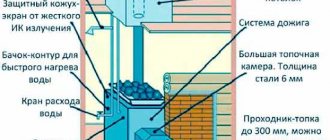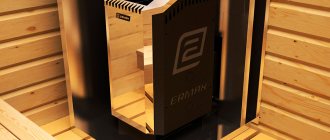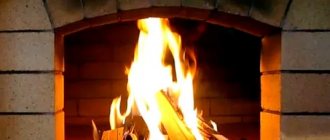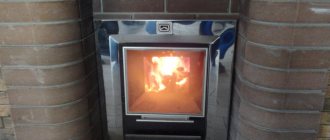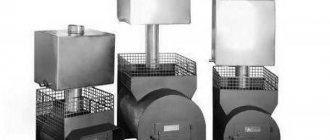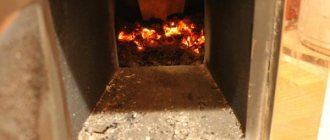In this article we will talk about the features of brick sauna stoves. Why do connoisseurs love them so much? And why unprepared people hate them. A brick stove for a bathhouse is a special stove. I'll tell you what you need to know before you start laying out a brick stove in your bathhouse.
In fact, now, behind many details and technologies, important fundamental things are not visible. These are not the same points from the textbook - the basics of bathhouse stove construction. Namely, thoughts based on the experience of my customers and friends. But any experience cannot be the ultimate truth. Perhaps what I call the advantage of a brick stove for a bathhouse will be a systemic disadvantage for some. It depends on which point of view you choose...
Sauna stoves
Many years ago, different nations had differences between baths. So, several centuries ago, the most common bathhouse in Russia was stone or clay . Brick was very expensive at that time. It was made by hand, so only rich people could purchase it. Over time, everything developed, the price of the material began to change, more people could afford it.
According to traditions, a Russian steam room must have a brick stove, which replaced the centuries-old stone one. The stove is an integral part of the bathhouse, its heart, and its choice must be taken very responsibly. A brick stove in a bathhouse is considered a classic for all its lovers.
There are a number of different types of additions and fireboxes for brick kilns:
- In black terms , there is no chimney, but there is more than enough aroma and steam, the disadvantage is that you had to wait a long time for the fuel to burn out.
- In gray – there is a chimney, heat is retained in the steam room, but it takes a lot of time to warm up.
- On white – there are no traces of soot, it stays warm for a long time, it can take up to 12 hours to warm up, it’s all about the specific build.
- With a stove is the most successful option; the structure includes a tank and bath stones. The tank is lined with a brick wall on three sides; the high temperature of the water is better preserved.
Since ancient times, to wash and cleanse the body, people poured water onto hot stones and breathed the hot air with pleasure. Later they began to build stoves, they were heated black. They poured water onto the stones with a ladle to create hot steam in the steam room. Currently, the structures are equipped with a chimney. However, some adherents of the Russian steam room still steam in black.
To questions about the “brickness” of the stove, the “closedness” of the heater and good steam
On forums and websites about stoves and baths, there are a lot of discussions about Russian baths and brick stoves, and that you can get good steam only with the help of a brick stove, from stones heated to a crimson glow. Let's try to dispel these judgments.
The brick oven is a relic from the century before last. This, like the black sauna, which you almost never find anymore, and brick ovens, have almost disappeared from our lives. If a heating stove for a home, as a historical necessity, had the right to life in its time, then a brick stove for a bathhouse is most likely an exception to the rule. Pleasure, both then and now, is expensive. Brick ovens are gradually becoming a thing of the past. A brick oven for a home is almost nothing but advantages, and even then it is becoming a thing of the past. A brick stove for a bathhouse is almost nothing but disadvantages, why should she linger. A brick stove for a public bathhouse somehow still has the right to life, but brick stoves for private bathhouses are supported only by stove makers, for whom this is a way of making money, misleading people, based on the quality of steam from a brick stove. And many of the stove makers don’t even know much about bath conditions. And only enthusiasts who believe in the light steam from a brick stove can afford a brick oven. The steam may be light, but it comes with difficulty. The place of brick stoves has been successfully taken by metal stoves with a closed heater and stone lining. It’s not at all difficult to make a stove from a metal stove that produces really light steam, is lightweight, economical, and inexpensive.
Most of the brick structures that remain are fireplaces, a design with low efficiency, and even then undeservedly. What has the right to life, either now or in the future, is the Russian stove. Ingenious design. And instead of a fireplace, and for barbecue, and simply, like a RUSSIAN OVEN. She alone unites all these structures.
When you compare steam from a brick stove and a metal one, you compare steam from a brick stove with a closed heater, with steam from a metal stove with an open heater, seasoned with powerful convection. The comparison is at least incorrect. You need to compare both stoves with a closed heater.
What's the first thing we'll talk about? About good and healthy steam. For a good and healthy climate in a steam room, several components are needed.
In the first place is the “closedness” of the heater, and let’s take it as an axiom. Since good steam can only be obtained using stoves with a closed heater. About terms. An open heater is when the stones are not covered with any kind of lid, the heater is always open, and you can see the stones. This is almost 100% of the metal sauna stoves produced. The disadvantage of stoves with an open heater is overheating of the steam room and insufficient heating of the stones. Yes, it’s a plus if there is still powerful convection. Being in such a steam room with overheated and overdried air is harmful. And the quality of the steam leaves much to be desired. Various tricks to increase humidity, with the installation of built-in and non-built-in steam generators and pouring water on walls and shelves, also do not lead to anything good. Convection nullifies all efforts. The correct ratio of humidity and temperature does not work out. The steam is either scalding or damp. The necessary conditions are obtained rarely and for a short time. If you heat the stove, the steam room overheats; if you don’t heat it, the stones quickly lose temperature. And if there is also a hot water tank on a pipe, a boring bathhouse turns into a fun pastime with water pouring. A closed heater is stones covered with a lid, and in order to add water to the stones, you need to open the lid. And the steam from a sauna stove with a closed heater is the best. Stoves with a closed heater come with direct heating of stones - periodic, and indirect heating, which can be heated continuously. The disadvantage of periodic stoves is precisely the frequency and the possibility of carbon monoxide poisoning. You must always “cook” the stove very correctly, know and be able to do it; any haste can lead to poisoning. It should be noted that there are fans of such a stove with “smoke”. Another disadvantage of stoves that directly heat stones is the relatively long preparation time for the bath, at least 2.5 - 3 hours. After heating the stove, you need to rake out the coals, pour the remaining coals with water, pour them onto the stones, close the damper and let them sit for half an hour. “Crimson stones” can be obtained in ovens with direct heating of the stones. But we’ll talk about the “raspberry” color of the stones later.
In second place is infrared radiation. A very important component. You could also say the main one. Heat is transferred in three ways: infrared radiation (wave transfer method), convection (heat transfer using air particles from a heated body to another body) and contact transfer.
It is infrared radiation that warms a person, it is it that heals him by penetrating into the internal organs of a person. A bathhouse with an infrared heat source has nothing in common with a conventional sauna. In a regular sauna, a heater heats the air, and then the air superficially warms the human body. This is a convection heating method. Heat does not penetrate inside a person. In a bath with an infrared heat source, a wave heating method is used. Infrared waves penetrate and warm the body and body tissues directly, without heating the surrounding air. The air is already heated by objects. Here we can give an example: on our body we feel the warmth of a sunbeam passing through a window, but the window glass always remains cool.
Such soft infrared heat is bioresonant for the internal tissues of a living organism and has a great influence on the processes occurring in them, triggering mechanisms for healing and cleansing the body. Due to deep penetration, infrared heat causes intense sweating. Infrared radiation affects the potential energy of the body's cells, unbound water leaves them, the activity of specific cellular structures increases, the level of immunoglobulins increases, and infrared radiation also increases the activity of enzymes and estrogens. This applies to all types of body cells and blood. Blood vessels dilate, blood flow accelerates, metabolism and sweating, cell growth and tissue regeneration increase. For infrared radiation to be useful, the temperature of the emitting body is important. Due to the limited size of the steam room, the temperature is needed from 120-130 C to 180-200 C. Temperatures below 120 C, for a metal stove, are not effective in a steam room, as it lengthens the warm-up time, and above 200 C, the steam room will quickly overheat, due to the fact that the oven is on the floor and convection currents are formed. Here, a brick oven has both advantages and disadvantages. The disadvantages are, of course, the inertia of the furnace. You need wood and time. The surface temperature of the walls is still rather low. Heating the oven further does not end well, the oven cracks. All stoves, whether metal or brick, must be operated in normal mode. Constant operation in borderline modes greatly reduces the service life of any furnace. And if the stove is heated normally, then a steam room with a brick stove is most likely a condensing one. The steam room is heated by steam when water is supplied to the stones, which then condenses on the human body, resulting in the appearance of sweating.
We’re simply not talking about brick stoves with open heaters. A brick sauna stove with an open heater is nonsense. Waste of money. Only shortcomings.
Metal stoves and infrared radiation. Here, of course, the inertia of the stove is minimal. The oven quickly enters the infrared radiation mode, but also quickly enters the short-wave radiation mode, which is already harmful to health. Such radiation is popularly called “hard”. But it’s not the hardness of the radiation that matters, it’s the power of the radiation. You just need to stay away from him. In the case of a steam room, just not in a steam room. Stoves are made mainly with open and convection heaters. In order to somehow warm up the stones, or in winter, if the bathhouse is not heated, the heat is high, the stove constantly operates in maximum mode, which is why the radiation power is high. There are several versions of metal furnaces. Metal stoves (usually homemade), without shielding of the firebox, with a single-wall chimney pipe - the most “hard” option, both burn and dry out the air. A softer option is a stove with a shielded firebox. Chimney pipes have options, there are single-walled and thermally insulated pipes, starter pipes with fins and stone nets. Heaters, ventilated and unventilated, convection and semi-closed, whatever you choose. But basically all heaters are open and convection. The vast majority of domestic and foreign manufacturers operate in this segment. Many of the stoves are marketed by manufacturers as stoves for Russian baths. Having bought these, the bathhouse people then practice on them how to curb the elements of “hard” infrared radiation and excessive convection, and how to adapt this miracle of engineering to obtain the regimes of a Russian bath. Basically, they line the stove with bricks, leaving the pipe bare; the advanced ones line the pipe and make a lid on the heater. The first option is completely bad. Unnecessarily reduce infrared radiation from the stove, leaving excess from the pipe. In the second case, they strongly “strangle” the entire oven, resulting in a smaller version of a brick oven. The inertia of the furnace increases, the metal furnace operates in harsh conditions, and its service life is greatly reduced. And the last option is metal-ceramic stoves made by sauna stove manufacturers. As a rule, all solutions are half-hearted. For normal work, there is always something missing or something extra. They leave the chimney pipe bare or there is unregulated convection, or all of the above. The metal furnace firebox and chimney is a medium-temperature infrared heat source. If you optimally screen the firebox and chimney and close the convection, you get an excellent stove for any sauna: infrared, Turkish, Russian and Finnish.
In third place is convection. The smaller the convection air flows in the steam room, the better the steam. Here the brick oven is, of course, at its best. Convection currents are minimal. Metal stoves generally lose out here. Moreover, a large number of stoves are produced with convection heaters. Manufacturers try to use convection to heat the air faster and bring the steam room to steam mode.
It is mistakenly believed that convection is very good, because it quickly warms up the bathhouse. Even metal stoves with a closed heater are available with convection holes. And here’s the mistake. The air in the steam room, constantly circulating past the hot firebox, becomes very dry. It’s 120 C to the beloved people, you can no longer breathe in the steam room. Besides, it is very harmful. Further, the situation is further aggravated by the fact that sweat from people begins to circulate with the air and burn out on the hot metal. And if the stove is made of ferrous metal, there is also a taste of oxidized metal. And all of this has to breathe.
The main advantage of such stoves is only a lower price. For many buyers, the price is a decisive factor, it and unfair advertising about a Russian bathhouse with such a stove are decisive for the purchase of a stove, they buy, and in return they most often receive disappointment.
But only in fourth place is the material from which the stove is made. An intermittent stove, with a closed heater made of metal, and even without shielding, does a good job of producing good steam, because While the oven is standing, infrared radiation decreases to acceptable values, and the air in the steam room cools down and is saturated with oxygen.
A properly designed stove with a closed heater, with an economizer, with an optimally shielded firebox, even made of metal (heat-resistant steel) produces excellent steam, and additionally shielded with stone tiles, it becomes ideal for a Russian bath.
And now the brick. A brick stove with an open heater is simply not a stove. It will burn a lot of wood, but there won’t be much use - the heater won’t heat up and the steam will only come from the bottom of the heater. Of course, there will be steam from a brick oven with a closed heater, but it is not worth the money spent, the mental effort to find a good project and a master to implement it. And yet, it may not work out. I lived in the village myself. For ten years, the stove was rebuilt almost every year, and only the last project turned out to be viable; the stove has been standing since 1973. And the work of a stove maker, whether good or bad, costs the same money. So it's Russian roulette. Of course, if you are sure that you only need a brick oven, then you need to lay it down, but first seriously understand these ovens and make the only right decision.
And finally, about the “raspberry” color of the stones. Good steam from stones heated to a crimson glow, or from cast iron. The fact is that water evaporates at a temperature of 100 C, and steam from either “raspberry” or not “raspberry” stones cannot have a temperature of more than 100 C. The “raspberry” color of the stones is important for periodic furnaces; the higher the temperature of the stones, the You can use the heated stove longer. For continuous ovens with a closed heater, the temperature of the stones is not so important; they always produce good steam. The main thing is that the container for stones is not made of ferrous metal. They opened the lid of the heater, added some water, and then closed it. Even when you have splashed on the stones and they no longer seem to hiss, you pour a few ladlefuls of water and close the heater. And the heater will produce good steam. After you think that the steam has already ended, you can steam a couple more times. But you only need to steam with the heater closed. It's always easy to breathe. And there will always be light steam.
And always an easy couple for you!
Brick oven
Sauna stoves are divided into two main categories - metal (cast iron) and brick .
Brick - placed mainly on the foundation . If it is not available at the beginning of construction, the floors are removed and the foundation is laid, only after that the main work is carried out. There are periodic and continuous actions. The difference lies in the heating of the stones - directly by fire or from the flooring. Such work is done by a professional mason. It is constructed from heat-resistant bricks.
Metal - installed independently , no foundation required, a sheet of iron is placed on the floor where the stove will be installed. A stove is installed on top. The duration of work can last from several days to several hours.
Supporters of the traditional steam room prefer a brick oven, but we must not forget that they not only have some advantages, but also disadvantages.
Sheathing stages
Before you line an iron stove with bricks in a bathhouse, you need to prepare. To carry out the work, the master will need M150 solid brick, clay, sand, concrete, crushed stone. To create the formwork you will need boards, waterproofing and rods for reinforcement. The tools you need to prepare are a level, a shovel, a tape measure, a pencil, a trowel, and a plumb line.
Attention! If the stove came complete with a convection casing, it must be removed, since its role is now played by the lining.
Today there are many types of iron stoves, the lining of each of them has certain nuances Source wp.com
Foundation construction
The strength of the stove structure and how long it will last will depend on the foundation, therefore, it is better to choose which stove in the bathhouse at the design stage. If the total weight of the stove with laid masonry is no more than 750 kg, a separate foundation will not be required for it. Otherwise, you will need to carry out a number of works to arrange a reliable foundation. In general, they do not differ from the work on arranging any other foundation:
- If the foundation is strip, then a pit is dug for it, in which the formwork is installed and waterproofed.
Heavy metal stoves will require a reinforced foundation Source banya-expert.com
- When the formwork is ready, a 20 cm layer of crushed stone and sand is poured over it, then it is watered and compacted.
- Reinforcement is laid and a mixture of concrete, sand and crushed stone is poured (in a ratio of 1: 4: 3). Everything is leveled up; if necessary, flaws are corrected.
- After the poured foundation is left to harden for approximately 14-20 days.
When the concrete has completely dried, the base is laid: waterproofing is made from roofing felt, and metal sheets 1-2 mm thick are laid on top of it, on which there will be an iron stove.
Advantages of a brick stove
- Brick and firewood are ecological materials that are harmless to human health. Hot bricks do not emit hazardous chemicals.
- The stove keeps heat for 6-8 hours without constantly adding firewood and warms up several rooms (depending on location).
- When heated, it releases steam, and when it cools down, moisture is absorbed, this is called “the stove breathes” or steam exchange occurs (it dries the steam room itself).
- Thanks to good heat exchange , a small amount of firewood is consumed and savings occur (the advantage of harvesting on your own).
- In case of a power outage or lack of gas supply, this is the best option.
- The chimney does not need monthly cleaning like a metal firebox.
- Pleasant appearance that does not require additional finishing.
- It is fireproof , since the surface does not heat up.
- It pleases the owner for a very long time, unlike metal ones.
The positive aspects are indisputable regarding the brick steam room - it is a pleasant microclimate (comfortable temperature and high humidity), which is created by steam, maintaining the temperature inside and outside the steam room.
Cons of a brick oven
- The structure is very large , a separate strong foundation is required, the area of the bath house should not be small.
- It takes about 6 hours , the stove is heated, and the steam room takes a long time to warm up.
- It is necessary to take bath procedures only after the firewood or other fuel has completely burned out, otherwise there is a risk of carbon monoxide poisoning .
- to clean the ash pan after each firebox - the place where burnt fuel remains accumulate and the chimney needs to be cleaned periodically.
- The construction of a firebox takes a long time and is very labor-intensive work, which can last up to two months .
- Prices for construction materials are not the cheapest .
- Finding a good, professional stove maker who can make a real sauna stove is very difficult , and the cost of his work is high.
Any mistake in construction can cause poor-quality use of the stove. It is necessary to balance everything: high-quality log house and its insulation, ventilation, financial capabilities.



